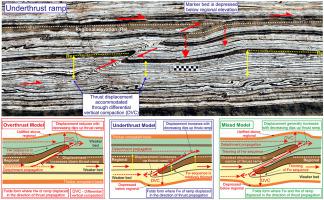Journal of Structural Geology ( IF 3.1 ) Pub Date : 2021-06-18 , DOI: 10.1016/j.jsg.2021.104396 G.I. Alsop , R. Weinberger , S. Marco , T. Levi

|
Although most models of thrusting assume that the hangingwall is actively displaced up the thrust ramp while the footwall remains passive, it has been suggested that this could be an oversimplification and the footwall may also deform. Despite this, there are relatively few detailed investigations of thrusts where the footwall is deformed, perhaps reflecting issues with space and accommodation if the footwall actively moves downwards to deeper levels. Furthermore, such studies assume that the thrust is deeply buried otherwise the hangingwall is more likely to rise and simply uplift the surface. Using examples from gravity-driven fold and thrust systems developed in unlithified late Pleistocene sediments around the Dead Sea Basin, we investigate pristine fold and thrust geometries unaffected by later compaction and deformation to establish two end-member models of overthrust and underthrust ramp development. During overthrusting, the hangingwall is uplifted and marker beds remain at or above regional elevation, whereas the footwall of underthrust ramps is depressed and marker beds are deflected below regional. The greatest displacement generally develops low down overthrust ramps and decreases upwards, whereas larger displacements form high up underthrust ramps and reduce downwards. The reduction in displacement in overthrust ramps is marked by decreasing dips, whereas displacement increases with decreasing dips up underthrust ramps. Fault propagation folding creates hangingwall antiforms above overthrust ramps, whereas footwall synforms develop below underthrust ramps. The effect of this folding is that hangingwall sequences and cut-offs are relatively thinned (stretch<1) in overthrust ramps, while footwall sequences and cut-offs are thinned in underthrust ramps (stretch>1). Not all ramps follow these end-member geometries and mixed ‘wedge’ ramps also develop in which the hangingwall and footwall to the ramp are both deformed to varying degrees. Underthrust ramps are generally developed where failure initiates in competent units higher up the deforming sequence, and then propagates downwards towards underlying potential detachments. Downward propagation is accommodated by footwall synforms and weak beds that absorb deformation by differential vertical compaction resulting in up to 50% thinning in some cases. A consequence of underthrusting is that the crests of hangingwall structures tend to remain at the same elevation and are therefore unable to build significant topography or bathymetry on the sediment-water interface thereby rendering critical taper models of less relevance. Significant vertical compaction may facilitate expulsion of fluids that drive further deformation and may also complicate the use of area balancing techniques during restoration of thrust systems.
中文翻译:

在重力驱动的折叠和推力系统中区分不同推力斜坡模型的标准
尽管大多数推力模型假设上壁主动向上推力斜坡移动,而下壁保持被动,但有人认为这可能过于简单化,下壁也可能变形。尽管如此,关于下盘变形的推力的详细研究相对较少,这可能反映了下盘主动向下移动到更深层次时的空间和调节问题。此外,这些研究假设推力被深埋,否则上墙更有可能上升并简单地抬升表面。使用在死海盆地周围未成岩的晚更新世沉积物中形成的重力驱动的褶皱和推力系统的例子,我们研究了不受后期压实和变形影响的原始褶皱和逆冲几何形状,以建立两个端部推覆和逆推坡发展模型。在逆冲过程中,上盘抬升,标志床保持在或高于区域高程,而逆冲斜坡的下盘被压低,标志床偏转低于区域。最大的位移通常形成低下的逆冲斜坡并向上减小,而较大的位移形成高的逆冲斜坡并向下减小。逆冲坡道中位移的减少以倾角减小为标志,而位移随着下冲坡道上倾角的减小而增加。断层传播折叠在逆冲坡道上方形成上盘反形态,而下盘同形体在逆冲坡道下方形成。这种折叠的影响是,逆冲坡道中的上盘层序和截止点相对变薄(伸展<1),而下冲坡道中的下盘层序和截止点变薄(伸展>1)。并非所有坡道都遵循这些端部构件几何形状,并且还会形成混合的“楔形”坡道,其中坡道的上墙和下墙都发生了不同程度的变形。逆冲坡道通常在变形序列更高的主管单元中开始失效,然后向下传播到潜在的潜在脱离。向下传播由下盘同形体和弱层提供,它们通过不同的垂直压实吸收变形,在某些情况下导致高达 50% 的变薄。下冲的结果是上墙结构的顶部往往保持在相同的高度,因此无法在沉积物 - 水界面上建立重要的地形或水深测量,从而使关键锥度模型的相关性降低。显着的垂直压实可能有助于排出驱动进一步变形的流体,并且还可能使推力系统恢复期间区域平衡技术的使用复杂化。



























 京公网安备 11010802027423号
京公网安备 11010802027423号